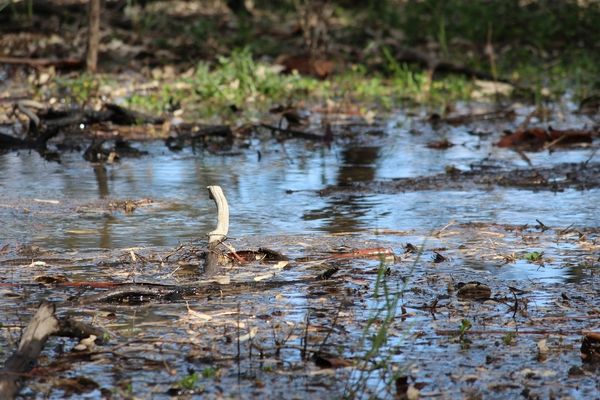Water for the environment to the rescue!
In Guttrum State Forest an urgent rescue mission is underway to save a culturally rich and ecologically significant wetland complex. The Victorian Environmental Water Holder (VEWH), North Central Catchment Management Authroity (CMA) and Barapa Barapa and Wamba Wemba Traditional Owners have worked together to deliver much needed water to the site and will monitor the outcomes of the environmental flows.
Reed Bed Swamp and Little Reed Bed Swamp are nestled low in Guttrum State Forest, on the Murray River near Koondrook. Environmental water managers and Traditional Owners have been increasingly worried that the wetland plants and large old red gum trees surrounding the wetlands were being stretched beyond their tolerances under persistently dry conditions.
“Prior to river regulation and European occupation, Reed Bed Swamp and Little Reed Bed next door would have naturally received some water on average nine out of every 10 years, usually over winter or spring,” North Central CMA Program Delivery Executive Manager Rachel Murphy said.
“The wetlands are fairly shallow and would often have dried out after about six to nine months, which provided the perfect conditions for wetland plants and animals to thrive.
Upstream river regulation has reduced the frequency, duration and magnitude of flooding in the forest.
“Modelling shows that even during the driest periods, including the devastating Millennium Drought, the mid-Murray floodplains would have historically received some water without river regulation. Given these swamps’ low-lying position on the floodplain, they would have received water most years even despite the dry conditions.” Rachel said.
Temporary pumps are currently being used to deliver a small allocation of water for the environment from the River Murray to the Guttrum Forest wetlands.
This recent allocation of water for the environment consisted entirely of return flows, water that has already come down the Campaspe and Goulburn rivers as part of the Victorian water for the environment program. Across Victoria a large proportion of water for the environment (88% in 2018-19) is reused at multiple sites as it travels downstream, supporting improved environmental outcomes again and again.
Environmental and cultural values
As recently as the 1990s, the swamps in Guttrum Forest were home to an abundance of important native plants such as old man weed, and the giant rushes the swamps are named after. The reeds and surrounding trees provided important habitat for birds such as the endangered Australasian bittern and colonial nesting waterbird species.
There are also a number of culturally significant old river red gums on the fringes of the wetlands, and the swamps are surrounded by archaeological evidence including large mounds and middens, indicating the area was once a highly productive landscape for local Aboriginal communities.
Local Barapa Barapa and Wamba Wemba Traditional Owners remember the wetlands being very different when they were kids. They remember them being a lot wetter and often there was a green carpet of native mudflat plants covering the wetlands’ beds.
“The watering of Guttrum Forest has been a long-term goal of the Traditional Owners of the area for many years,” the Barapa Barapa Wamba Wemba Water for Country steering committee said.
“Guttrum Forest is an ideal place for bird watching, an important breeding site for native wildlife, including water birds, with trails that wind through majestic river red gum and canoe trails to explore the winding waterways.”
“The wetlands are of regional significance and have enormous cultural importance to the Wamba Wemba and Barapa Barapa People.
“The watering of the Reed Bed Swamp in Guttrum Forest is good thing for the future of the forest and the region, with a regular water regime the long-term health of the landscape is ensured.”
The North Central CMA, the VEWH and local Traditional Owners are working on a rehabilitation plan for the swamp complex.
“Traditional Owners will help the CMA monitor the watering and look at the response of the wetland from an ecological perspective, as well as monitor the cultural values of the area, and the VEWH is pleased to be able to help make this happen,” VEWH Commissioner Rueben Berg said.
“The Barapa and Wamba communities have been engaged for several years now to talk about reinstating the natural flooding regime and have waited a long time to see the return of water to Reed Bed and Little Reed Bed swamps,” Rueben said.

Guttrum Forest during watering, by North Central CMA